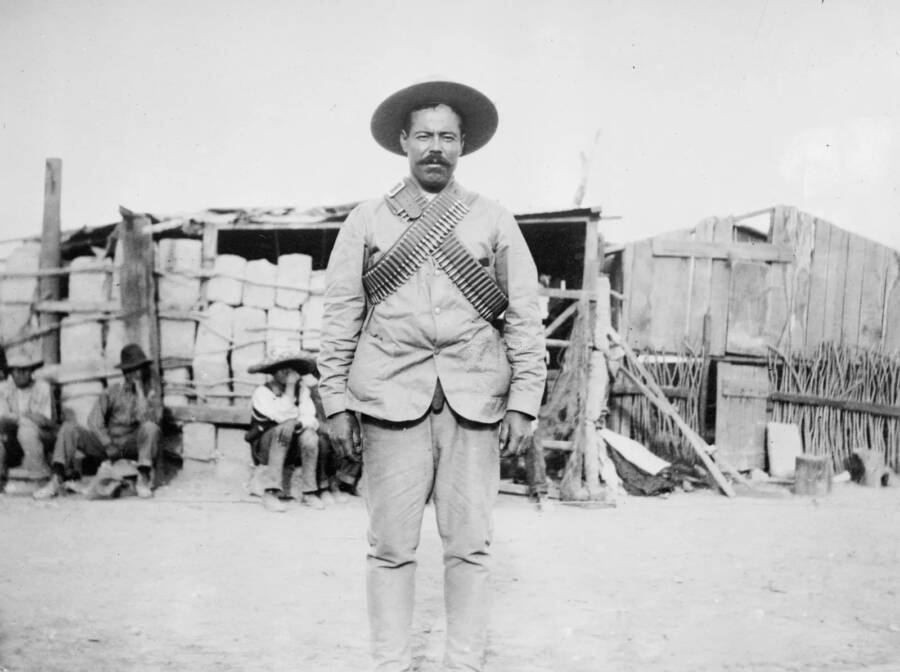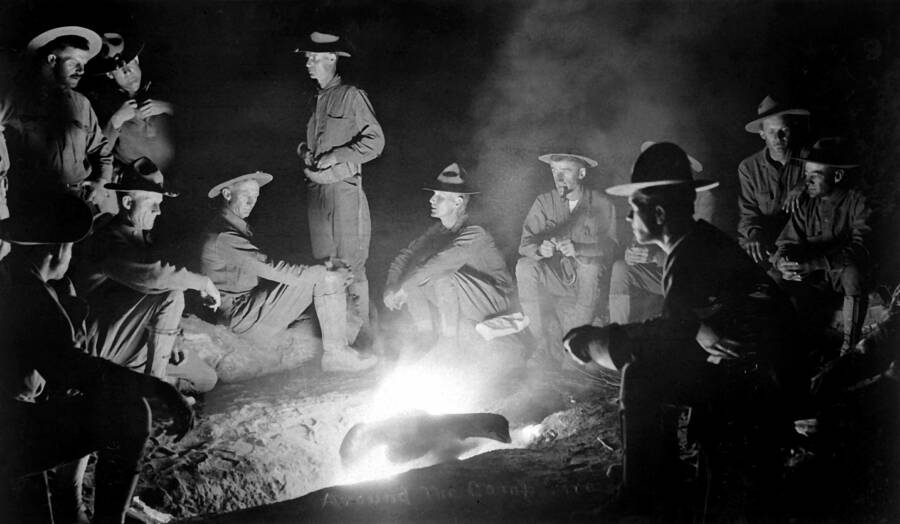A former bandit, Francisco "Pancho" Villa became one of the most renowned generals in the Mexican Revolution — and fought tirelessly for the poor.

Library of CongressToday, Pancho Villa is sometimes remembered as a folk hero, with some comparing him to Robin Hood.
In 1910, the Mexican Revolution saw numerous revolutionaries rise up to overthrow dictator Porfirio Díaz. Though the ousting was successful, the aftermath was chaos. One of the revolution’s leaders, Francisco Madero, took Díaz’s place as the country’s president, but was assassinated in 1913 by ally-turned-adversary Victoriano Huerta.
From there, several factions of rebels clashed, each hoping to install their own leadership in the country.
One of these groups was the División del Norte, or Division of the North, led by Pancho Villa. A revolutionary who fought tirelessly for the poor, Villa had once been allied with both Madero and Huerta, but Huerta eventually accused Villa of thievery. At one point, Villa was at risk of being executed, but Madero intervened at the last minute to save his life. However, Villa was still sentenced to prison as Huerta turned against Madero as well.
Following Madero’s death, Huerta became Mexico’s new dictator. So, after Villa escaped prison, he and another revolutionary, Venustiano Carranza, joined forces to once again oust a ruler. Though Huerta was gone by 1914, the conflicts between revolutionaries were far from over. Villa would go on to clash with Carranza and make several enemies in Mexico and, eventually, the U.S., until the revolution came to a close and Villa himself was assassinated.
This is the true story of Pancho Villa, the bandit-turned-revolutionary who would go down in history as the “Robin Hood of Mexico.”
Pancho Villa: From Fugitive To Revolutionary
Pancho Villa was born José Doroteo Arango Arámbula on June 5, 1878, in San Juan del Rio, Durango, Mexico. He was the son of a field laborer and had a limited education, but he learned to read and write. After the death of his father, Villa took a job as a sharecropper to support his family.
But Villa’s employment at a hacienda would not last long. At age 16, he learned that the owner of the hacienda either assaulted or planned to assault Villa’s sister. Furious, Villa shot the owner and fled the property.
According to the Library of Congress, he was briefly imprisoned in San Juan del Rio, but quickly escaped. As a fugitive, he became a bandit.
Villa spent about six years on the run in the mountains and eventually became the leader of a group of fellow bandits. At some point, he changed his name to Francisco “Pancho” Villa, likely to avoid being imprisoned again. Meanwhile, he started developing a Robin Hood-like reputation.

Library of CongressPancho Villa with a group of his fellow revolutionaries.
As a bandit, Pancho Villa often stole cattle and money from the wealthy and gave his spoils to the poor. It’s believed that he did this because he had already experienced the plight of the impoverished and had seen how some wealthy people manipulated them to become even wealthier.
Eventually, Villa slowly ventured back into society in the state of Chihuahua and worked as a miner and a meat seller, but his reputation as a bandit preceded him. In particular, his exploits caught the eye of a group of revolutionaries who were planning to overthrow dictator Porfirio Díaz.
In 1910, just as the Mexican Revolution was beginning, Villa joined the fight alongside revolutionary figure Francisco Madero, who promised to make sweeping changes for Mexico’s lower classes, according to ThoughtCo.
Villa so impressed Madero with his skills as a fighter, his extensive knowledge of the land, his ability to evade capture, and his literacy despite a lack of formal education that Madero appointed him as one of the revolutionary army’s primary leaders. And by May 1911, Díaz had resigned from power and gone into exile. But the revolution was far from over.
A Series Of Clashes And Conflicts
For a brief period of time, it seemed like Pancho Villa was ready to live a quiet life. After all, Díaz was gone and Madero had taken his place. And Villa had also begun to spar with another commander, Pascual Orozco, Jr.
But after Villa tried to leave the army behind, he soon learned that Orozco had felt so embittered by being left out of Madero’s new government that he decided to rebel against the new president in 1912. Villa worked with General Victoriano Huerta to come to Madero’s aid and helped to stifle the rebellion.
However, according to Britannica, Huerta grew suspicious of Villa during their short time as allies. At one point, he accused Pancho Villa of horse theft and even condemned him to death. Luckily for Villa, he received a reprieve from Madero that saved him from execution, but Villa was still jailed in June 1912.
Later that same year, Villa managed to escape from prison and fled to the United States. But he soon learned that Huerta, who had once been an ally of Madero, had now become his adversary. And in February 1913, Huerta assassinated Madero and claimed the presidency for himself.

Library of CongressPancho Villa riding and leading a group of his men.
After Madero’s death, Pancho Villa came back to Mexico, determined to fight back against Huerta, who would soon become yet another dictator of the country. He assembled several thousand men as the División del Norte (or Division of the North) and valiantly led his soldiers into battle after battle.
Villa also found valuable new allies in Venustiano Carranza and Emiliano Zapata, who were just as determined as Villa to remove Huerta from power. But since many of Villa’s battles were close to the U.S.-Mexico border, he received the most attention from the nearby Americans.
Though Villa had once hidden his face as a fugitive, he loved being photographed as a revolutionary. In fact, he even signed a contract with Hollywood’s Mutual Film Company in 1913 to ensure that his leadership in battles would be recorded. Around this time, Villa also briefly served as the provisional governor of the state of Chihuahua.
By 1914, Huerta had been ousted from power and Carranza had taken his place as the leader of the country. But peace was not on the horizon, and tensions would soon flare between Villa and Carranza.
The Complicated Legacy Of Pancho Villa
Pancho Villa once reportedly said, “I am not an educated man. I never had an opportunity to learn anything except how to fight.” And with numerous conflicts under his belt, he soon rebelled against Carranza’s rule with the support of the U.S. government, ready to take down yet another politician.
But eventually, Carranza began to slowly steer the country toward democracy, leading U.S. officials to take his side. After President Woodrow Wilson withdrew his support of Villa, Villa was so infuriated that he took bloody revenge in 1916 by kidnapping and killing 18 Americans on a Mexican train. According to HISTORY, Pancho Villa then attacked the town of Columbus, New Mexico, causing the deaths of 19 more people there.
Because of this, Villa was soon villainized in the American press and President Wilson sent General John J. Pershing and thousands of U.S. soldiers to Mexico to track Villa down, but no one was able to find him.
In the meantime, Villa continued his guerrilla campaign against Carranza for the next four years until Carranza was assassinated in 1920 (the same year that’s sometimes cited as the end of the Mexican Revolution). Politician Adolfo de la Huerta then took Carranza’s place as president.

Public DomainA group of men enlisted to search for Pancho Villa, known as the Pancho Villa Expedition, pictured in 1916.
Determined to bring an end to Mexico’s conflicts, de la Huerta made a direct appeal to Villa to retire from his revolutionary and political activities. In exchange for a pardon, a ranch, and a pension, Villa agreed to retire.
But unfortunately for Pancho Villa, his retirement wouldn’t last long before he met a brutal death. After enjoying about three years of peace, he was gunned down by a group of assassins who shot at his car about 40 times on July 20, 1923 in Parral, Chihuahua, Mexico. He was 45 years old.
A man named Jesus Salas Barraza later confessed to killing Villa, but while he was initially sentenced to 20 years in prison, he was pardoned just six months later. According to the El Paso Times, this was because Pancho Villa’s death was seen as “beneficial to the country.” It is widely believed that Salas Barraza was not working alone and that he took the position as the “fall guy” so that higher-ranking government officials would avoid suspicion.
In the decades since then, Pancho Villa’s legacy has remained one of both legend and controversy. His tireless advocacy for the poor has cemented his long-lasting reputation as the “Robin Hood of Mexico,” but his banditry, bloody clashes with former allies, and his attacks on American soil ensured that he would be seen as a villain in some circles rather than a hero.
As for Villa himself, he would probably like to be remembered for just one thing: “My sole ambition is to rid Mexico of the class that has oppressed her and give the people a chance to know what real liberty means. And if I could bring that about today by giving up my life, I would do it gladly.”
After reading about the life and death of Pancho Villa, discover the true stories of other figures from folklore, like Rob Roy MacGregor and Ned Kelly.





